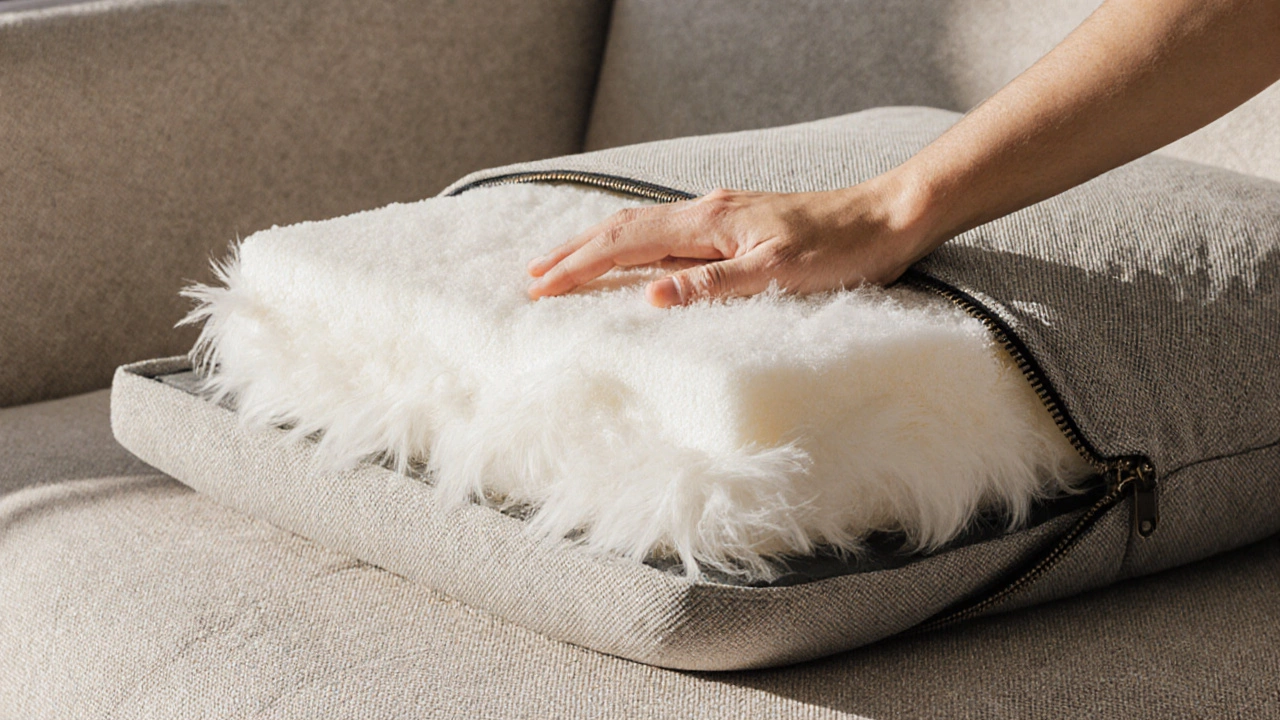Couch Quality Checker
Test Your Couch
Answer these questions to determine if your couch is built to last. Based on the article: How to Tell if a Couch Is High-Quality.
Quality Assessment
Strengths
Weaknesses
Final Recommendation
Buying a couch that lasts more than two years feels like a lottery. You spend hundreds-or thousands-on something you sit on every day, only to watch the cushions flatten, the fabric pill, and the frame wobble after a few seasons. The truth? Most couches sold today are built to be replaced, not kept. But not all of them. If you know what to look for, you can spot a high-quality couch from a mile away. And it has nothing to do with brand names or how it looks in a staged living room.
Check the Frame First-It’s the Skeleton
The frame is the foundation. If it’s weak, nothing else matters. A high-quality couch uses kiln-dried hardwood like oak, maple, or beech. You won’t find particleboard, plywood, or plastic here. These materials flex, crack, and break under pressure. Hardwood frames are heavier-often over 100 pounds for a standard three-seater. Pick up one corner of the couch. If it feels light and flimsy, walk away.
Look at the joints. A well-built frame is held together with corner blocks, dowels, and glue-not just staples or nails. Run your fingers along the underside. You should see solid wood blocks screwed or glued into the corners. If you see only metal brackets or exposed screws sticking out, that’s a red flag. Reputable makers like Stickley, Herman Miller, or even well-made IKEA models (like the KIVIK) use these techniques. Cheaper brands rely on glue and nails that fail within a year or two.
Test the Cushion Fill-It’s What You Actually Sit On
Cushions are where most couches die. You sink in, and five minutes later, they’re flat. That’s not comfort-that’s poor engineering. High-quality cushions use a mix of materials: high-density foam (at least 2.5 pounds per cubic foot) wrapped in feather or down clusters. The foam gives structure; the down gives softness.
Here’s how to test it: press your hand firmly into the seat cushion. If it compresses easily and doesn’t spring back within 3-5 seconds, it’s low-density foam. That’s the kind that turns to mush after six months. A good cushion should push back with firm resistance. Then, flip the cushion over. If you see a zipper, unzip it (yes, ask the salesperson). Look inside. You should see a layer of foam, then a soft wrap of feathers or polyester fiber. If it’s all foam or all fiber, it won’t last.
Down-filled cushions need regular fluffing, but they last 10-15 years. Foam-only cushions start to sag after 2-3 years. The best compromise? Foam core with a down blend. It holds shape, feels luxurious, and doesn’t require daily maintenance.
Look at the Spring System-No One Talks About This
Most modern couches skip traditional springs entirely. Instead, they use elastic webbing-cheap, stretchy strips that sag over time. A high-quality couch uses eight-way hand-tied springs. These are metal coils, individually tied with twine in a grid pattern. Each spring moves independently, giving you even support no matter where you sit.
You won’t see these springs unless you flip the couch over. But you can feel them. Sit on the couch and shift your weight side to side. If you feel a consistent, bouncy support without any saggy spots or clicking noises, it’s likely hand-tied. If the whole seat feels like a trampoline with dead zones, it’s webbing. Webbing lasts 3-5 years. Hand-tied springs last 20+ years. That’s the difference between buying a couch and buying a piece of furniture.

Examine the Fabric-Durability Over Looks
That velvet you love? It’s gorgeous, but it’s not durable. A high-quality couch uses performance fabrics: abrasion-resistant materials tested for 20,000+ double rubs. The Martindale test measures how long fabric lasts under friction. Anything under 15,000 double rubs is for decorative use only. Look for 25,000-30,000. That’s what you’ll find in high-end brands like Maharam, Crypton, or Sunbrella.
Check the weave. Tight, dense weaves last longer than loose or fluffy ones. Run your fingers over the surface. If it feels thin or fuzzy, it will pill quickly. Also, look at the backing. A good couch has a woven cotton or polyester backing behind the fabric. That prevents the fabric from stretching or tearing over time. If the backing is missing or flimsy, the upholstery won’t hold up.
Check the Legs and Arms-Details Matter
Legs and arms are often the first parts to break. A high-quality couch has solid wood legs, screwed into the frame-not glued or stapled. Test them by gently rocking the couch. If the legs wobble or feel loose, the attachment is weak. Look for metal brackets or wood dowels reinforcing the connection.
Armrests should be thick, padded, and securely attached. Press down on the arm. If it sinks more than an inch or feels hollow, it’s stuffed with low-density foam or fiber. A good armrest has a firm core, wrapped in soft padding. It should feel supportive, not like a pillow you can squish flat.

Ask About the Warranty-The Real Test
A high-quality couch comes with a warranty that covers the frame and springs for at least 10 years. Some premium brands offer lifetime warranties on the frame. If the warranty only covers the fabric for one year, or excludes the cushions entirely, that’s a warning. You’re paying for longevity, not just style.
Don’t be fooled by extended warranties sold at checkout. Those are profit centers for stores. Focus on the manufacturer’s warranty. If they won’t give you a written copy, walk away. Reputable makers like Roche Bobois, Poltrona Frau, or even Canadian-made brands like Duxiana stand behind their products. If the warranty is vague or missing, the couch probably isn’t built to last.
Do the ‘Sit Test’-Your Body Knows Best
After checking the frame, springs, and fabric, sit on it. Not for five seconds. Sit for 15 minutes. Read a book. Shift positions. Lie back. Pay attention to how your lower back feels. Does it slump? Do your hips sink too far? Does the cushion feel like it’s pushing back in the right places?
A high-quality couch supports your posture. It doesn’t force you to hunch or slide forward. It cradles you without swallowing you. If you feel pressure on your thighs or your back aches after 10 minutes, it’s not the right fit. Comfort isn’t about softness-it’s about alignment.
Also, check the depth. A couch that’s too deep (over 24 inches) makes it hard to sit upright. Too shallow (under 20 inches) and you’ll feel like you’re perched on the edge. The sweet spot? 21-23 inches. That’s what most ergonomic designers recommend.
And don’t forget the arm height. Your arms should rest naturally, with your elbows at a 90-degree angle. If you have to hunch your shoulders or lift your arms to rest them, the couch is wrong for your body.
High-quality couches aren’t flashy. They don’t need to be. They’re built to be lived in-for years, not seasons. They’re heavier, quieter, and more expensive. But they’re also the only ones you’ll still be sitting on when your kids are grown, your partner is retired, and your grandkids are asking, “Who made this?”
Can a couch last 20 years?
Yes-if it’s built with a hardwood frame, eight-way hand-tied springs, high-density foam (2.5+ lb/ft³), and a durable fabric rated for 25,000+ double rubs. Brands like Stickley, Poltrona Frau, and Duxiana have couches that last decades. Most store-bought couches won’t, because they’re made with particleboard, elastic webbing, and low-grade foam.
Is leather better than fabric for durability?
Leather can be more durable, but only if it’s full-grain or top-grain. Avoid bonded or corrected leather-it’s just crushed scraps glued together. Full-grain leather lasts 20+ years and develops a beautiful patina. Fabric wins if it’s a high-performance weave like Crypton or Sunbrella. Both can last decades, but leather resists stains better, while fabric offers more color and texture options.
What’s the best cushion fill for a family with kids or pets?
High-density foam (3.0 lb/ft³) wrapped in polyester fiber is ideal. It holds its shape under heavy use and is easy to clean. Avoid down or feather blends-they get messy and need constant fluffing. Look for removable, machine-washable covers. Brands like IKEA’s KIVIK or Lulu and Georgia offer great options for families.
Why do some couches squeak or creak?
Squeaking usually means the frame joints are loose or the springs are rubbing against metal. In cheap couches, nails or staples loosen over time. In quality ones, dowels and corner blocks are glued and screwed tightly. If your couch creaks when you sit down, it’s a sign the structure is failing. A well-built couch should be silent.
Should I buy a couch online without testing it?
Only if the company has a generous return policy (at least 100 days) and provides detailed specs: frame material, foam density, fabric rating, and spring type. Brands like Burrow, Floyd, and Article offer this. Avoid buying from unknown sellers on Amazon or Facebook Marketplace unless you can verify the construction. A couch is a long-term investment-don’t gamble on looks alone.







